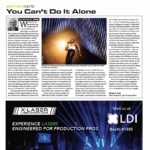In the 1950s, George Izenour designed an electronically-controlled line shaft system for the theatre at Hofstra University. It was a very flexible system in which the sheaves and blocks could be moved around using a matrix of bolt holes on a series of beams in the fly loft. Several AC synchronous motors were mounted on the back wall of the theatre and Izenour designed a controller that ran the motors and controlled the line sets. Unfortunately, the technology at the time was such that the motors were not able to be controlled accurately enough for the application and the battens would sometimes crash to the floor.
Contrast that with the video tape wars of the 1970s when Betamax was competing with VHS. Many people agree that Betamax was superior to VHS in terms of picture quality, durability and engineering. It was also the first to market with high-fidelity sound, and it was faster to transition between stop, play, rewind, and fast forward. Plus, it allowed for digital freeze frame long before it was available on VHS. But Betamax suffered from drawbacks including shorter recording times than VHS, and it eventually lost the battle for market domination.
When Izenour designed and built an automated line shaft system, the technology wasn’t ready for such an application. In the case of Betamax, the technology was fine but the market wasn’t ready for it. These are the two extremes and the in-between is where most of us reside. If you tend to spend more time wading in the shallow end of the technology pool, then you’re going to find it more difficult to navigate the coming tsunami of technological development.
The lighting industry is undergoing radical changes, and it’s not going to wait for you to put down your sandwich and pull out the instruction manual. Everything from control protocols to lamp sources and many things in between is changing before our very eyes. It’s flowering like time-lapsed photography. At times it can be challenging to keep up and still maintain your regular work load, your family life, your outside relationships and your other interests. Sometimes it feels like you have to choose between keeping up and having a life.
The good news is that there are more resources than ever to help you get up the learning curve as quickly as possible and stay up with the changing industry. There are books, magazines, social networking sites, Web pages, distance learning opportunities, seminars and trade shows, all of which are aimed at keeping you informed and educated. The not-so-good news is that there are more books, magazines, social networking sites, Web pages, distance learning opportunities, seminars and trade shows than you can shake a stick at. And they don’t just magically get absorbed into your brain. It takes effort on your part to take advantage of them.
Now I’ll let you in on a little secret. Are you ready? Okay, here goes. Studies show that fractional hours summed with other fractional hours add up to whole hours. Fifteen minutes here, fifteen minutes there, and before you know it you’ve put together an entire hour. Go figure. The quality of learning is not compromised by breaking it into bite-sized units. In fact, sometimes it helps to absorb more information by allowing you to digest it in smaller quantities. Take a drink, take a rest, go on about your business and come back for more later on.
You do have to keep up with the fast pace of technology, but you don’t have to meet death-by-learning in order to do so. You can mingle your daily tasks with learning a bit here and a bit there and still meet your quota of learning on a daily basis. It makes learning more interesting and enjoyable, and it still allows you to balance your checkbook and your life. So take a walk on the wired side, and plug in to more learning opportunities.


